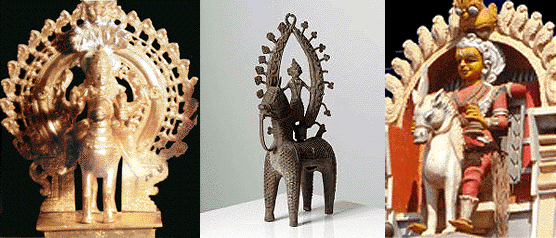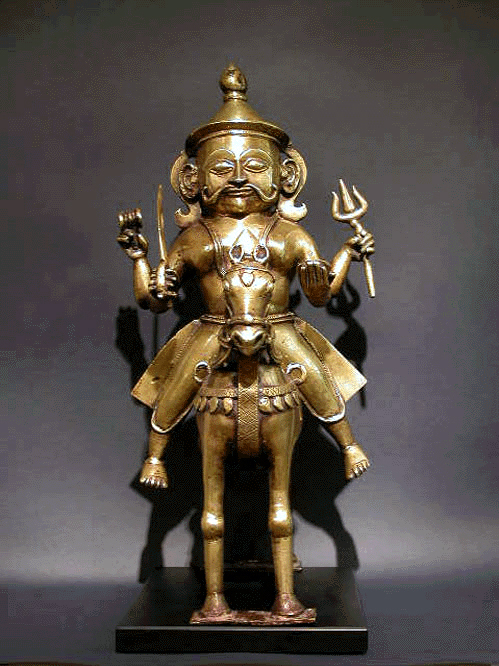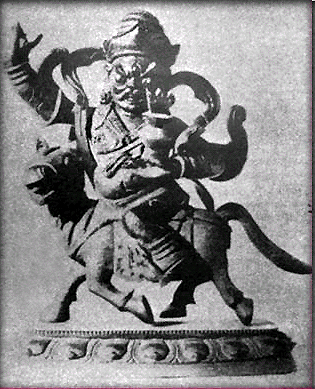
|
|
Worship of Lord Brahma, Part 67
BY: SUN STAFF

Lord Brahma as Bermer (left, center) and subsequent adaptation (right)
Mar 29, 2018 — CANADA (SUN) — A serial exploration of places of Lord Brahma's worship.
Proliferation of the Brahma Cult
As we prepare to move from Kerala to Karnataka on our journey to Brahmadeva tirthas, we cross a fascinating historical 'bridge' that connects these two states, and leads us back in time, back to North India, and into the Middle East.
In a segment to come, we will be making a connection between Lord Brahma and the Buddhist religion, and the convergence of Vaisnava, Saivite, and Buddhist traditions at the Khadri Manjunatha Temple in Mangalore, Karnataka. In a description of how the Saivites came to worship the Kadri Brahamdeva deity as Lord Shiva Manjunatha, we will hear the pastimes of Parasurama and Manjunatha, taken from the Bharadwaja Samhita.
Lord Parasurama, one of the Dasavatar incarnations of Vishnu, destroyed the Kshatriya kings and warriors 21 times consecutively, and eventually donated their confiscated lands to the sage Kashyapa. Lord Shiva, manifesting in Karnataka as Manjunatha, instructed Parasurama to worship him at Kadri from a distance of 10 yojanas. This distance refers to Parasurama's abode at Sahyadri Mountain, a mountain range running the length of the Western Ghats, into Karnataka and Kerala.
Lord Parasurama is considered to be the founder of Kerala State, which did not exist prior to his appearance. In the pastime of determining which lands Parasurama would inhabit after slaying the Kshatriyas, he threw his axe into the sea. Varuna, the demigod in charges of the oceans, made the sea retreat to the point where the axe fell, thus creating the land of Kerala.
Just as we find a close relationship between Kerala and Karnataka in the pastimes of Parasurama, we find a similar close connection with respect to the worship of Lord Brahma in these two places. At Khadri Manjunatha Temple, the Vaisnava, Shaivite and Buddhist traditions converged in Brahma's worship, but in Kerala, an even greater convergence took shape.
In both Kerala and Karnataka, like everywhere in India, there are many small religious cults that have some connection to the main trunks of Vaisnava or Shaivite philosophy. These are generally found to be tribal cults who had previously engaged in nature or spirit worship and other rudimentary religious forms, eventually incorporating higher forms of worship, e.g., worshipping members of the Trimurti. Not surprisingly, there is a wide array of these tribal practices, which fall outside the bounds of the bona fide sampradayas. A similar phenomenon is found in Orissa, with proliferation of the tribal roots of Jagannath worship.
In Kerala, we find an example of a tribal cult that developed a very organized form of worship -- the Tulu, who worship Bermer, a tribal form of Brahma worship. The Tulu settled in Kerala after having migrated from Pirak (now the region of Pakistan). The origination of the Tulu's worship of Lord Brahma is believed by some historians and archeologists to be linked to the origination of the Abrahamic cult in the Middle East, which grew into the Judeo Christian religions.
There is apparently also evidence that in the north of India, this tribal Bermer (Brahma) worship was a precursor to the Brahmadeva worship in Pushkar, Rajasthan, and the Bermer deity form is thought by some to have been the original form of Brahmadeva worshipped at Pushkar, with the Catur-mukhya form coming later.
The 'Bermer' Cult of Brahma
The cult of 'Bermer' worship is said to have been introduced to the Karavali-Tulunadu in South India by the Early Tulu, who were Dravida immigrants, ca. 800-600 B.C. While some have mistakenly traced the origin of the Bermer/Brahma cult back to the legend of Abraham, we know that it was actually transmitted to, and not from, the Abraham cult via contact between brahmans from India and the Persians, who then carried it further west.
Excavations at Pirak, a settlement of about ten hectares inhabited between 1800 and 600 B.C. in the region now known as Pakistan, reveals a cultural transition in the area. Several miniature clay figures of horsemen and horses and of two-humped camels – animals that had been previously unknown in the Indus civilization – marked important changes in the society.
At Tulu-Research.blogspot.com, we find a description of the origination of 'Bermer' in the Pirak region, paraphrased below.
The place name Pirak, where several early Indian tribes, including Vedic and Tulu tribes lived, was formed by the words pirak in Tulu, prak in Prakrit and Sanskrit, which means 'ancient'. This conjunction of words was probably formed after the tribes migrated from the Pirak area into India. All these tribes may have worshipped Brahma or the Brahman referred to in the Vedas and Upanishads. The Tulu people called their early God 'Bermer' which is the respectful word for Brahma, pronounced berm'er. The –er is a plural indicative or respect indicative suffix in Tulu.
The migrating Tulu tribes later carried Bermer to their Tulunada homeland in South India. Bermer was the prominent God worshipped by the Tulu people for centuries. Bermere gunda or Brahmasthana (Brahma's shrine) are still existing in many Tulunada villages. The garodis (traditional gymnasiums of Tulunada) had idols of the God Bermer. The lyrical folk literature of the Tulu people, pad-dhana, describes Tulu heroes Koti and Chennaya, who also worshiped the God Bermer.
Interestingly, the idols of Bermer, in most cases know to this researcher, were represented by a human male figure mounted on a horse. Italian tourist Della Valle who visited Queen Abbakka Devi at Ullal, a small coastal town south of Mangalore, Karnataka during 1623 A.D., also described a similar idol of Bermer, within a small shrine in the area.
With the ascent of Shiva and Durga worships in Tulunada, the Bermer concept is now slowly vanishing. The word Bermer was further extended as a suffix denoting God as Naga bermer, also worshipped by Tulu people. In the case of the Tulu tribe, it appears that Brahma (Bermer) worship has evolved with the passage of time. The relics of the early clay horse and rider figures found in Pirak by archeological excavation teams (ca.1700 B.C.) may well represent Brahma/Bermer as he has been worshipped by the Tulu people for countless years.

Shiva Khandoba
Maharashtra bronze, early 18th c.
While the original Brahma figure of a human male astride a horse is thought to have been worshipped as Lord Brahma the Creator by early Tulu and Vedic tribes, subsequently, as the Shiva and Vishnu cults became more popular and worship of Brahmadeva waned, the original horse-seated Brahma may have evolved into a four faced, catur-mukha Brahma, while the personality riding the horse became associated more with Lord Shiva in forms tinged with tribal spirit worship, such as Khandoba in Maharashtra, Mallanna in Andhra Pradesh, and Mundittaya in Tulunadu.
Undoubtedly, the migrant Tulu tribes carried the worship of Bermer with them to Tulunada well before Shaivism made a major impact in southern India. Shiva worship in Tulunada, as evidenced by dating the various linga and Shiva murtis there, was initiated in the early part of the Christian era.
The influence of the Tulu's worship of Brahma/Bermer is still found today in Karnataka today, where it is actively practiced at the Shree Brahma Baidharkala Temple in Mangalore, where Koti-Chennaya are worshipped as great spirit leaders. Also worshipped at that temple is the Bermer/Brahma deity that had been worshipped by Koti and Chennaya themselves.
Like the tribal Brahma worshippers in the Sacred Groves, which we will be discussing in a future segment, the Koti Chennaya cult has integrated various tribalistic forms of worship of the bhutas or daivas, which are also dove-tailed into their program of Brahma worship. Some of the religious practices found in the Tulunadu community cross over into demoniac practices similar to today's Kali cult, e.g., drinking chicken blood, and the like. This is not surprising, given that the derivation of this Brahma worship is very rudimentary and amalgamated, unlike the pure Puranic Brahma, the Brahma of the Trimurti understood and glorified by the Vaisnavas.
Before moving on to the Brahma tirthas in Karnataka, tomorrow we will continue to explore the concept of early Brahma worship in North India, the introduction of Bermer, and the Brahminic influence that traveled from North India into Persia and the city of Ur, in ancient Afghanistan. There we find the connection between worship of Brahma-Saraswati of the Vedas, and Abraham-Sara of the Judeo-Christian religion – often seen as a bearded Abraham astride a horse.

Abrahamic Brahma on Horse
SERIES INDEX:
Part 1 - Brahma-Karmali in Carambolim, Valpoi, Goa
Part 2 - Pushkar, Rajasthan
Part 3 - Chinch & Asotra, Rajasthan
Part 4 - Eklingji, Udaipur, Rajasthan)
Part 5 - Vasantgarh, Rajasthan)
Part 6 (Rajasthan: Bijoila, Mewar; Chandravati, Sirohi; Kiradu & Sevadi, Jodphur)
Part 7 (Khokhan, Himachal Pradesh)
Part 8 (Tihri-Uttarsal, Himachal Pradesh)
Part 9 (Una, Himachal Pradesh)
Part 10 (Dudhahi, Lalitpur, Uttar Pradesh)
Part 11 (Gaya, Bihar)
Part 12 (Tirupati, Andhra Pradesh)
Part 13 (Alampur, Andhra Pradesh)
Part 14 (Kaleshwar, Karimnagar, Andhra Pradesh)
Part 15 (Sampradaya Acarya - Lingampally, Andhra Pradesh)
Part 16 (Manthani, Andhra Pradesh)
Part 17 (Gurramguda Village, Andhra Pradesh)
Part 18 (Tirusulam, Tamil Nadu)
Part 19 (Kanchipuram, Tamil Nadu)
Part 20 (Kanchipuram, Tamil Nadu)
Part 21 (Kanchipuram, Tamil Nadu)
Part 22 (Kanchipuram, Tamil Nadu)
Part 23 (Kanchipuram, Tamil Nadu)
Part 24 (Syncretistic Forms of Lord Brahma)
Part 25 (Thirupachur, Tamil Nadu)
Part 26 (Pancheshti/Pancheti, Tamil Nadu)
Part 27 (Pallavaram, Tamil Nadu)
Part 28 (Chengalpattu, Tamil Nadu)
Part 29 (Mandagappattu, Tamil Nadu)
Part 30 (Mahabalipuram, Tamil Nadu)
Part 31 (Mahabalipuram, Tamil Nadu)
Part 32 (Thirumukkoodal, Tamil Nadu)
Part 33 (Thiruvannamalai, Tamil Nadu)
Part 34 (Thirunaraiyur, Tamil Nadu)
Part 35 (Thirunaraiyur, Tamil Nadu)
Part 36 (Thiruvengadu, Tamil Nadu)
Part 37 (Thiruvelliyankudi, Tamil Nadu)
Part 38 (Kuthanoor, Tamil Nadu)
Part 39 (Lalgudi, Tamil Nadu)
Part 40 (Kulithalai, Tamil Nadu)
Part 41 (Tiruchirapalli, Tamil Nadu)
Part 42 (Thirupattur, Tamil Nadu)
Part 43 (Pullamangai, Tamil Nadu)
Part 44 (Kumbakonam, Tamil Nadu)
Part 45 (Sri Rangam, Tamil Nadu)
Part 46 (Tanjore, Tamil Nadu)
Part 47 (Kumbakonam, Tamil Nadu)
Part 48 (Kumbakonam, Tamil Nadu)
Part 49 (Darasuram, Tamil Nadu)
Part 50 (Thirukkannapuram, Tamil Nadu)
Part 51 (Malayadipatti, Tamil Nadu)
Part 52 (Thiruvadi, Tamil Nadu)
Part 53 (Thirukandiyur, Tamil Nadu)
Part 54 (Thiruparangundram, Tamil Nadu)
Part 55 (Kodumudi, Tamil Nadu)
Part 56 (Thottiyam, Tamil Nadu)
Part 57 (Nallur, Tamil Nadu)
Part 58 (Kanniyakumari, Tamil Nadu)
Part 59 (Purusha Sukta - The Hymn of Creation)
Part 60 (Kottakkal, Kerala)
Part 61 (Thirunavaya, Kerala)
Part 62 (Triprayar, Kerala)
Part 63 (Kodakkal, Kerala)
Part 64 (Chottanikkara, Kerala)
Part 65 (Thiruvananthapuram, Kerala)
Part 66 (Thiruvallam, Kerala)
Part 67 (Tulunadu to Ur - Proliferation of Brahma Cult)

The Sun
News
Editorials
Features
Sun Blogs
Classifieds
Events
Recipes
PodCasts
About
Submit an Article
Contact Us
Advertise
HareKrsna.com
Copyright 2005, 2018, HareKrsna.com. All rights reserved.
|
|

